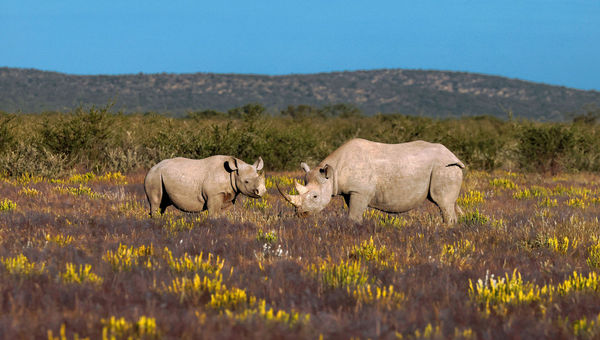Although Etosha National Park is renowned as Namibia’s prime wildlife destination, just beyond its southern boundary lies the stunning Etosha Heights Private Reserve. Spanning 250 square miles, this reserve offers visitors an exceptional wildlife viewing experience without the usual crowds. Remarkably, the reserve operates entirely on tourism revenue, making it a standout example of successful conservation efforts in Africa.
Founded in collaboration with local landowners in 2017 by Natural Selection Travel, the formerly barren cattle ranches and hunting concessions have been transformed into a vibrant wildlife habitat.
The outcomes are impressive: the elephant population has soared to over 270—previously, these majestic creatures avoided the area entirely. Lion numbers have increased to more than 30, while the reserve now boasts a thriving population of 370 giraffes, among the healthiest in the region. Additionally, Etosha Heights serves as an essential roosting site for two vulnerable vulture species endemic to Namibia.
Perhaps the most compelling narrative here is that of the rhinos. Designated as a Black Rhino Custodian area, the reserve is home to both black and white rhinos, benefitting from round-the-clock protection provided by a specialized anti-poaching team. This initiative is financed through a 1.5% revenue contribution from guests, which also covers costs for advanced monitoring technology and gyrocopter patrols.
Conservation Efforts at the Forefront
Central to this conservation initiative is the Etosha Heights Conservation Centre. In collaboration with the Giraffe Conservation Foundation and Namibia University of Science & Technology, the center informs comprehensive conservation strategies across the Greater Etosha area. Just this year, it has facilitated research covering topics like predator-prey dynamics and elephant movement patterns.
The forward momentum is palpable, with four successful giraffe translocations already completed this year. The documented achievements of the reserve are capturing the interest of researchers and conservation groups seeking scalable models for sustainable practices.
A safari vehicle explores the breathtaking landscapes of Etosha Heights Private Reserve in Namibia. Photo Credit: Natural Selection
International researchers and conservation organizations are increasingly drawn to the reserve’s conservation successes, eager to adopt similar models. As noted by Jennifer Lalley, co-founder and Chief Impact Officer of Natural Selection, “Conservation is a long game, and Etosha Heights is proving what’s possible when land is given back to nature and people collaborate with patience, respect, and vision.”
Experiencing Conservation Firsthand
For travelers, Etosha Heights offers an enriching opportunity to engage with these conservation efforts through a selection of distinct accommodations. The Safarihoek Lodge features 11 thatched chalets named after local trees. Each unit includes family configurations and accessible options, blending modern interiors with traditional Namibian architecture, offering spectacular wilderness views from private balconies.
For those drawn to the rugged terrain, Etosha Mountain Lodge presents nine classic Namibian chalets nestled among dolomite hills, complemented by a refreshing swimming pool. This location is ideal for spotting mountain zebras, kudus, and elusive big cats.
For unparalleled privacy and luxury, Safari House offers a traditional Namibian farmhouse with exclusive use, three ensuite bedrooms, and personalized services including a dedicated guide and chef.
Exciting Game Drives and Night Safaris
Game drives are available both during the day and night, offering guests the chance to view diverse wildlife such as desert-adapted Hartmann’s mountain zebras, oryx, and a plethora of savanna species, including giraffes and kudus. The area’s healthy predator population also means frequent sightings of lions, leopards, and cheetahs. For a unique experience, specialized rhino-tracking drives allow for encounters with black and white rhinos in their natural habitat.
The reserve also features a double-story photography hide overlooking a busy natural waterhole. Designed by a Namibian wildlife photographer, this hide provides both ground-level and elevated viewing positions, equipped with charging stations and gear storage, making it a favorite for photographers. Wildlife frequents the waterhole throughout the day, with floodlighting allowing for extended evening viewing opportunities.
After sunset, night drives unveil a different spectrum of wildlife, featuring spotted hyenas, various jackal species, bat-eared foxes, and the elusive honey badger. Additionally, guided walks with armed rangers offer an intimate approach, allowing guests to track rhino footprints and explore the intricate details of the ecosystem.
In-Depth Conservation Experiences
Beyond the standard activities, the reserve provides deeper conservation experiences tailored for interested guests. The Etosha Heights Conservation Centre hosts specialized presentations on giraffe conservation and other ongoing research initiatives, helping visitors understand the scientific work funded by their stay.

Black and white rhinos enjoy 24/7 protection in Etosha Heights through specialized anti-poaching efforts. Photo Credit: Natural Selection
For guests seeking a more profound connection, the reserve can arrange immersive conservation activities that let them actively participate in wildlife monitoring and habitat restoration efforts.
Ultimately, visiting Etosha Heights not only offers an exclusive wildlife-viewing experience away from the crowds but also directly contributes to anti-poaching initiatives, ongoing research, and community development programs, sustaining the rich biodiversity of this cherished landscape.



